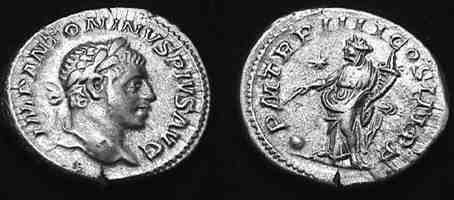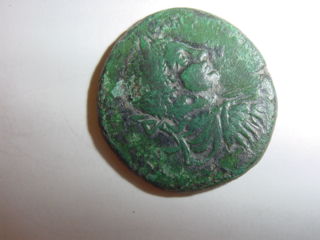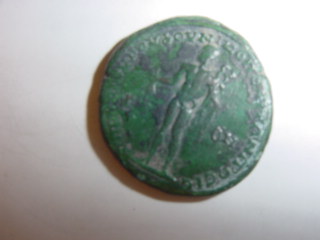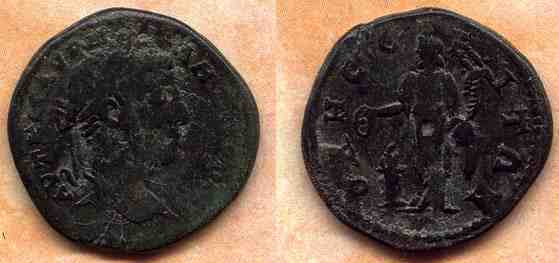Elagabalus
Varius Avitus Bassianus Marcus Aurelius Antoninus
CommonName: Elagabalus
FullName: Varius Avitus Bassianus Marcus Aurelius Antoninus,
Elagabalus
Reign: 218-222 AD
Title: Emperor
Born: 204 AD
Died: 222 AD
Relationship: Second cousin of Caracalla
Born Varius Avitus Bassus, son of a senator from Syria married to a
niece of Julia Domna, this youth (14 on his accession) was the hereditary
priest of the Syrian Ba'al and sun-god Elagabalus (El-Gabal) of Emesa.
His main attribute was his appearance; it allowed him to make his elaborate
ritual into an unusually spectacular show. His grandmother Julia Maesa
had greater ambition for him, however.
When Macrinus had the amazingly stupid idea to send Maesa packing back
to Syria, she immediately set about plotting. With lavish expenditure of
the accumulated treasure of the family she bribed most of Macrinus's troops,
also encouraging them by spreading the rumor that Elagabalus was in fact
the illegitimate son of Caracalla, with the result that Macrinus was heavily
defeated on 8 June 218. The new Augustus with his entourage traveled to
Rome.
Trouble began almost immediately. Elagabalus took his old job as priest
a lot more seriously than he did his new job as emperor. He celebrated
the rites of his cult in Nikomedia, putting on a spectacle all the more
notable because of the greater resources available to him. This foretaste
of his style of rule disgusted most of the Romans, and many of the provincials
as well. Elagabalus was a religious fanatic in the worst sense of the word,
and as his religion promoted all sorts of dubious morality - not for nothing
are the various Ba'al cults condemned in the Bible, for example - discontent
grew rapidly. The complete refusal of Elagabalus to show the least respect
for Roman tradition, such as wearing "normal" Roman clothing when he addressed
the Senate, did not help. Elagabalus brought the black (meteoritic) stone
of Elagabalus from Emesa to Rome, and carried on its cult there.
His private life was regarded as scandalous as well. He is supposed
to have married five wives in four years: Julia Paula (219-220), Julia
Severa (220-1), Annia Faustina (221-2), two unknown (222), and then Julia
Severa again; soon after which he was killed. Julia Severa was a Vestal
Virgin; Elagabalus claimed religious sanction, in that he as a priest was
marrying her as a priestess. He did not save himself for his wives; the
story of his being married to a "husband", Hierocles, cannot be easily
dismissed as mere malicious gossip.
His strange conduct alarmed Maesa, who began to look for an alternative.
She had another daughter, Julia Mamaea, who had a son Marcus Julius Gessius
Alexianus, who seemed considerably better behaved, although in 221 he was
only thirteen years old.
Accordingly Maesa persuaded Elagabalus to adopt this cousin. Since,
however, Alexianus, renamed Marcus Aurelius Severus Alexander in 221, was
much more popular with both Senate and army than Elagabalus, the latter
soon came to regret the adoption. He attempted to have his cousin assassinated;
Maesa used this to work on the soldiers' discontent, and they mutinied,
killed Elagabalus and his mother Soaemias, and subjected the bodies to
the usual indignities. The stone of Emesa was sent back to that city.
Home
---------------------------------------------------------------------------------------------------------------------------------------------------------

Elagabalus, 218-222, A.D., Denarius, Obverse: IMP ANTONINVS PIVS AVG
Emperor's portrait left. Reverse: PMTRP IIII COS II PP figure standing
half left, holding rod on extended hand and cornucopiae, globe by crossed
legs star above. This coin is well centered and sharply struck. RSC 189
variety, RIC 42
---------------------------------------------------------------------------------------------------------------------------------------------------------


Elagabalus Moesia Inferior, Nikopolis 218-222 AD AE27; Laur, Draped
and Cuir. Bust r./Hermes stg. L. Holding purse and Caduceus. Unlisted in
BMC,and COP
---------------------------------------------------------------------------------------------------------------------------------------------------------

Moesia Inferior, Markianopolis. 218 - 222 AD. AE- Pentassarion.
ELAGABALUS & JULIA MAESA. AE 25 mm. Confronted busts of Elagabalus
& Maesa. / Homonoia or Concordia stg. left holding patera and cornucopiae,
altar at feet. SGI 3146 var


